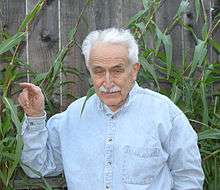Fred Iltis
Fred Iltis (Brno, Czechoslovakia, April 20, 1923 – San Jose, California, December 11, 2008) was an American entomologist. His research focused on the biosystematics and life cycle of mosquitoes.
Fred Iltis | |
|---|---|
 Fred Iltis with Zea diploperennis in 2005 | |
| Born | Wilfred Gregor Iltis April 20, 1923 |
| Died | December 11, 2008 |
| Alma mater |
|
| Scientific career | |
| Fields | Entomology |
| Institutions | |
Life and work
He was born Wilfred Gregor Iltis to Anni (née Liebscher) and Hugo Iltis, a botanist and geneticist who was a life sciences teacher at the German-language gymnasium of Brünn (Brno). His father was also the first biographer of Gregor Mendel[1] and a vocal opponent of Nazi "racial science". In the fall of 1938, the Iltis family was granted visas to enter the United States thanks to the intercession of the Emergency Committee in Aid of Displaced Foreign Scholars, along with affidavits of endorsement from Albert Einstein and Franz Boas. In January 1939, when Hitler's military was preparing the invasion of Czechoslovakia, fifteen-year-old Wilfred escaped with his mother and his younger brother Hugh on a harrowing train ride that traversed Nazi Germany to France. During a midnight stop at the Stuttgart station, Gestapo officers combed the train, removing ten passengers; the Iltises survived because the boys pretended to be asleep while their mother pretended to be the wife of a French diplomat. In Cherbourg, they were joined by Hugo Iltis and boarded the passenger ship RMS Aquitania for the Atlantic crossing. They settled in Fredericksburg, Virginia, where the senior Hugo Iltis was soon appointed to a professorship in biology at Mary Washington College.
Iltis began his undergraduate studies in 1941 at George Washington University but after one semester transferred to Western Kentucky State Teachers College, pursuing a major in agriculture.[2] During World War II, Fred Iltis served in the Army in the South Pacific. In 1948, he married Julia Patricia Zrinyi (Judy) (1926-2004), a graphic artist and scientific illustrator.[3] He went on to earn a Ph.D. in entomology at University of California, Davis.[3]
Iltis worked briefly at Harvard in 1967-1968 as a research fellow in Tropical Public Health for the Harvard School of Public Health.[4] After settling in San Jose, California, in the 1960s, Iltis taught in the Biology Department at San José State University.[3]
Iltis was a skilled photographer. He developed and printed photos in a basement darkroom, using the slow and complicated archival process system yielding prints that last many decades. In his journeys south of the border (where he met the Mexican photographer Manuel Álvarez Bravo), Iltis portrayed the life of the Mexican Indians, particularly in Michoacán. Many photos of his vast archive document the Civil rights movement of the 1960s, student protests against the Vietnam War, the struggle of the Chicano agricultural workers led by César Chávez and Dolores Huerta, as well as the strikes and boycott of American fruit companies. He met and befriended the renowned photojournalists Hansel Mieth and Otto Hagel, who had documented the Great Depression of the 1930s in Life magazine. From them Iltis learned that "a photo can express one’s ideas and ideals far better than a thousand words".
References
- M. Turda and P.J. Weindling, eds. "Blood and Homeland": Eugenics and Racial Nationalism in Central and Southeast Europe, 1900-1940. Budapest: Central European University Press, 2007.
- http://digitalcommons.wku.edu/dlsc_ua_records/3851/
- "Archived copy" (PDF). Archived from the original (PDF) on 2010-06-10. Retrieved 2009-10-02.CS1 maint: archived copy as title (link)
- https://www.myheritage.com/research/record-90100-346295035/harvard-school-of-public-health-cambridge-mass-annual-catalog-vol
Publications
- Iltis, Wilfred Gregor. "Biosystematics of the Culex pipiens complex in Northern California, Davis, California, 1966." Ph.D. diss., University of California, Davis, 1977.
Literature
- Daniele Ravenna, Felix Humm, Fred Iltis. Biologist, Photographer and Friend, Milano, DR&C Editore, 2009. ISBN 978-88-904465-0-4.